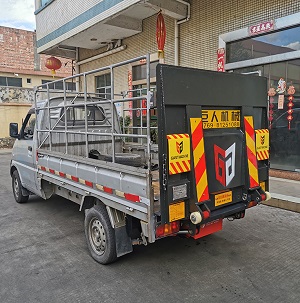
In the field of logistics and transportation, the tailboard of a vehicle, as a convenient auxiliary equipment for loading and unloading, its application effect is closely related to the carrying capacity of the vehicle. If the vehicle's carrying capacity does not match the tailgate of the car, it will not only affect the loading and unloading operations but also may bring potential risks. Understanding the requirements of the tailgate for the vehicle's load-bearing capacity and the key to using the tailgate.
The curb weight of the vehicle is the primary consideration. Curb weight refers to the vehicle's own weight when it is unloaded. After installing the tailgate, the total weight of the vehicle will increase. Generally speaking, the tailboard of a car has a certain weight, ranging from tens of kilograms to over a hundred kilograms. When choosing a tailboard, it is necessary to ensure that the total weight of the vehicle after the tailboard is installed does not exceed the allowable total mass designed for the vehicle. For instance, a certain type of light truck allows a total mass of 4,500 kilograms and has a curb weight of 2,000 kilograms. If a 200-kilogram tailboard is to be installed, the load capacity left for the goods should be controlled within 2,300 kilograms to ensure that the vehicle does not overload during operation.

The chassis structure and strength of a vehicle have a significant impact on its load-bearing capacity. The tailboard of a car is installed at the rear of the vehicle. Its weight and the force generated when loading and unloading goods all need to be transmitted to the wheels and the ground through the chassis. The longitudinal beams and crossbeams of the chassis are the main load-bearing components. If the chassis structure is weak, it will be difficult to bear the weight of the tailboard and the cargo, and deformation, fracture and other situations may occur. The chassis strength of different types of vehicles varies. Generally, the chassis of a truck is more robust than that of a bus and is more suitable for installing tailboards with a larger load capacity. Before installation, the vehicle chassis should be inspected and evaluated to check for any rust, cracks or other issues. If there are any defects that affect strength, they should be repaired or reinforced first; otherwise, installation is not recommended.
The rated load capacity of the tailgate of a vehicle also needs to be compatible with the vehicle's carrying capacity. The rated load capacity of the tailboard refers to the weight it can safely carry. Common specifications include 500 kilograms, 1000 kilograms, 2000 kilograms, etc. The rated load capacity of a vehicle is the allowable loading capacity specified in the design. After installing the tailboard, the actual weight of the goods that can be loaded will be reduced due to the weight of the tailboard. For instance, a vehicle with a rated load capacity of 3,000 kilograms is equipped with a tailboard with a rated load capacity of 1,000 kilograms and a self-weight of 150 kilograms. At this point, the actual weight of the goods that the vehicle can carry needs to be comprehensively considered. It cannot simply subtract the self-weight of the tailboard from the rated load capacity. The dynamic forces during the vehicle's operation also need to be taken into account. Generally, a certain allowance for bearing capacity is reserved to ensure safety.
The suspension system of the vehicle should not be ignored either. The suspension system serves to support the vehicle body and cushion vibrations. After installing the tailgate, the weight at the rear of the vehicle increases, which will change the load distribution between the front and rear axles of the vehicle. If the suspension system has insufficient load-bearing capacity, the vehicle may experience body tilting and reduced shock absorption during driving, which can affect handling and stability. For vehicles with limited carrying capacity, if a heavier tailboard is to be installed, it is advisable to upgrade the suspension system, such as replacing the springs with higher strength or adding auxiliary steel plates, to enhance the load-bearing capacity of the suspension system and make it adapt to the weight of the tailboard and the cargo.

Professional to provide security
for modern logistics
A new company that efficiently handles
and unloads equipment
Please do not hesitate to contact us
0769-81251088

Add friend consultation